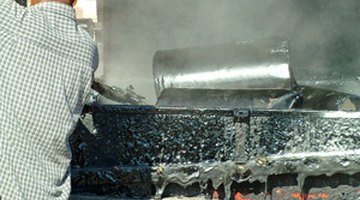Roofing Tar Risks
Roofing tar is used to create a waterproof skin on flat roofs. Unlike slanted roofs, which are adequately protected by shingles, flat roofs require true waterproofing because water and snow will sit motionless on them for long periods. Roofing tar is applied hot in liquid form and solidifies as it cools, creating a waterproof barrier. Hot tar presents multiple health hazards to workers.
Fumes

The fumes emitted by hot tar are not healthy. They can cause headaches and feelings of illness if breathed for too long or in too high a concentration. Exposure of pregnant women to roofing tar fumes can cause birth defects in their babies, according to literature published by the University of Western Ontario. Roofing tar fumes can also irritate people with asthma or other respiratory problems. Hydrogen sulfide is present in roofing tar and is the compound that gives the tar its distinctive and unpleasant odor.
Burns
Roofing tar is applied by heating it up to high temperatures so that it liquifies, then applying it to a roof with mops. Liquified tar is extremely dangerous and causes severe burns when it comes in contact with skin. Injuries occur when tar is spilled or splashed while it is being applied to the roof. When tar begins to cool, it goes from being slick and liquid to being sticky and viscous, which can cause it to adhere to skin, making injuries and burns more severe. The proper response to tar exposure is to cool the tar down quickly with large amounts of water, but not to try to remove it from the skin, as this could make the injury worse.
Slips and Falls
Because tar is slippery when it is first applied, it presents slipping and falling risks to workers. Falls are made more dangerous by the risk of falling into the hot tar or off of the roof. Workers must be careful to apply tar in an organized way that avoids the need to walk on the wet tar.
Dropped Tar
On large jobs, tar is often transported to the roof through pipes from a tar truck. However, on smaller jobs workers sometimes transport tar in buckets carried up ladders. This is an extremely hazardous activity, simultaneously exposing the worker and anyone else in the vicinity to both burn and fall hazards. If the bucket of hot tar is accidentally dropped from a ladder, it could splash a long way and injure anyone who is hit.
References
Writer Bio
Jagg Xaxx has been writing since 1983. His primary areas of writing include surrealism, Buddhist iconography and environmental issues. Xaxx worked as a cabinetmaker for 12 years, as well as building and renovating several houses. Xaxx holds a Doctor of Philosophy in art history from the University of Manchester in the U.K.
Photo Credits
- tar,roofing image by Greg Pickens from Fotolia.com
More Articles



